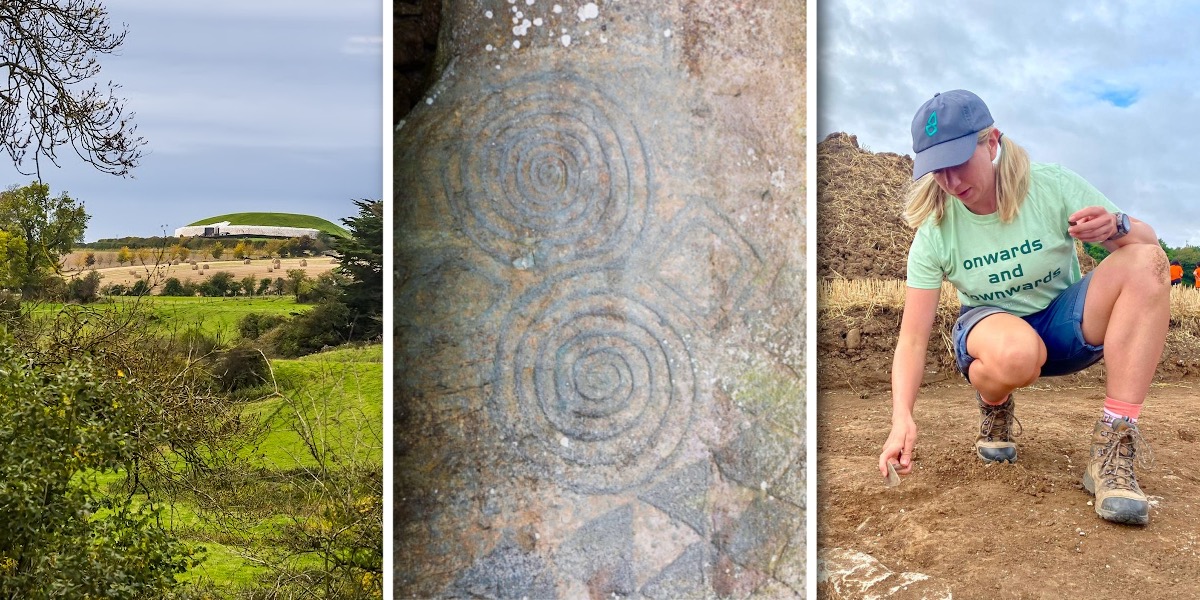Fieldwork
This listing expired on July 12, 2023. Please contact bookings@digventures.com for any updated information.

Location: Meath, Co. Meath, Ireland
Season: July 4, 2023 to July 16, 2023
Session Dates: 04 - 16 July 2023
Application Deadline: July 3, 2023
Deadline Type: Rolling
Website: https://digventures.com/product/archaeology-fieldschool-in-the-boyne-valley/
Program Type:
Field School
RPA Certified:
No
Affiliation:
DigVentures and University College Dublin School of Archaeology
Project Director:
Dr Brendon Wilkins and Dr Stephen Davis
Project Description:
Build your archaeological skills and help investigate the hidden world of Neolithic monuments that has recently been revealed by geophysical survey south of the River Boyne from the Brú na Bóinne UNESCO World Heritage Site.
The Boyne Valley, County Meath, is home to some of the best-preserved Neolithic sites in the world. Among the most famous is the World Heritage Site of Brú na Bóinne; a spectacular funerary landscape of standing stones, henges, and passage tombs dominated by the monuments of Newgrange, Knowth, and Dowth – situated on a bend in the north bank of the River Boyne.
At over 5,000 years old, these incredible structures contain the largest collection of megalithic art in Western Europe, and were clearly built with a sophisticated knowledge of science and astronomy.
So far, most archaeological investigation into the Boyne Valley’s prehistory has been tightly focussed on the monuments at the heart of this World Heritage Site.
But as archaeological awareness spreads out into the wider valley, including south of the river, a growing body of evidence is showing that these monuments did not stand in isolation; they are surrounded by a hidden world of buried monuments teeming with evidence of the people who built them.
In the last 10 years, large-scale geophysical research by University College Dublin (UCD) School of Archaeology and the Romano-Germanic Commission (RGK), Frankfurt, along with INSTAR-funded lidar, satellite, and palaeoenvironmental surveys of Brú na Bóinne, has a revealed a hidden landscape of henges, timber enclosures, ritual structures, palisades, and the remains of vast wooden monuments. Some of them are so large that they are estimated to have required 14,000 trees cut down to make.
The scale of these new discoveries is immense; and none of them have been excavated yet.
DigVentures is partnering with Dr Stephen Davis of UCD School of Archaeology to conduct the first excavations of these new discoveries, and begin a new phase of archaeological investigation into the Boyne Valley – and you can be part of it.
In partnership with Dr Stephen Davis of UCD School of Archaeology, we’ll be investigating two major new sites revealed by recent geophysical surveys south of the River Boyne, near Donore.
Both sites are located within the buffer zone of the Brú na Bóinne World Heritage Site, and include:
– A ceremonial avenue
– A Neolithic causewayed enclosure
— What you’ll learn —
DigVentures provides hands-on learning in small groups under the guidance of experienced archaeological supervisors. Our emphasis is on giving you practical experience that places you right at the heart of the archaeological action. Our team will be on-hand to guide your search for evidence every step of the way, giving you the confidence to be involved in excavating, recording, discussing, and interpreting our discoveries together.
1. Introduction to Irish and Neolithic archaeology
You’ll learn contextual archaeological knowledge including:
Archaeological practice in Ireland
Irish Neolithic and Megalithic archaeology
Landscape and funerary archaeology
2. Practical archaeological field skills
You’ll learn practical archaeological field skills, including:
Stratigraphic excavation
Recording archaeological finds, features, and contexts
Finds identification and processing
Survey (walk-over, LiDAR, geophysics)
Illustration and reconstruction
3. Additional workshops and events
You’ll also have opportunities to join us for:
Stone carving and/or lithics workshop
Social events and / or supplementary talks from the project team
You’ll also have plenty of opportunity to visit sites like Bru na Boinne, Hill of Tara, and more, in your spare time.
4. After field school
Once our fieldwork is complete, we’ll keep you updated with what happens next. You’ll be able to learn more through things like:
Updates on the Dig Timeline about the post-excavation process
Opportunities to join online talks or events when we have significant news to share
Receive a copy of the official Dig Report – with your name in the credits!
Period(s) of Occupation: Neolithic
Notes:
This fieldschool is run in partnership by DigVentures and Dr Stephen Davis of University College Dublin School of Archaeology.
We recommend bringing an Archaeological Skills Passport to record the skills you gain.
Project Size: 1-24 participants
Minimum Length of Stay for Volunteers: Six days
Minimum Age: 18
Experience Required: This field school is ideal for people who want to build their archaeological experience and already have a basic understanding of core archaeological fieldwork principles, including: - Stratigraphy and stratigraphic excavation - How to recognise new archaeological contexts or features - Basic principles of recording You can demonstrate this by completing: - An online course, such as DigVentures online course How To Do Archaeology, AND / OR - At least two days experience on another dig (this can be with any archaeological organisation, including DigVentures) You don’t need to meet these requirements before you book your place, but we do recommend that you have met them before you arrive at fieldschool.
Room and Board Arrangements:
Food, transport, and accommodation are not included. Participants will need to be independent travellers who are able to make their own arrangements. Suggestions are provided on the booking page.
DigVentures
5 Witham Studios, Hall Street,
Barnard Castle
County Durham
DL12 8JB
UK
The AIA is North America's largest and oldest nonprofit organization dedicated to archaeology. The Institute advances awareness, education, fieldwork, preservation, publication, and research of archaeological sites and cultural heritage throughout the world. Your contribution makes a difference.
Notifications